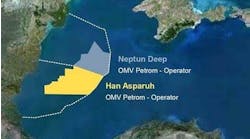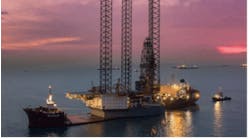Mark Carter, vice president
Swanson Industries, Morgantown, WV
John D. Hunter, manager of Marketing and Sales
Carpenter Powder Products, Division of Carpenter Technology Corp.
Bridgeville, PA -- To extend tensioner service life, Carpenter Powder Products offers a cobalt based alloy that could be laser cladded. Riser and guideline tensioners work in the corrosive "splash zone" area exposed to repeated cycles of saltwater wetting and drying. Such cycles can accelerate corrosion. In addition, there is wear resulting from the force of salt spray hitting the metal surfaces of the tensioners. Both of these conditions can lead to failures and downtime.
Improvements in material performance are shown with the application ofMicro-Melt CCW alloy – a cobalt-base powder metal alloy – to the tensioners via laser cladding by Swanson Industries.
Historically tensioners are fabricated from various carbon steel alloys, which then are coated with chrome, 316 stainless steel, or other corrosion resistant alloys. Those coatings generally are applied via conventional means in thicknesses up to 0.02 in. (0.5mm). The service life expectancy is two to three years due to the development of cracks in the relatively rigid coatings applied to these flexible components.
Laser cladding enables rapid heat transfer to form a metallurgical bond between an alloy, and its specified properties, and the component substrate, which is something that does not occur with a mechanical bond. It results in minimal inter-metallic dilution, a narrow heat-affected zone and low thermal distortion.
Micro-Melt CCW is a wear and corrosion resistant powder metal cobalt base material produced via gas atomization. Laboratory tests on coated samples show the material's durability. These include crevice corrosion testing, boiling acid testing, and salt spray exposure. Wear resistance in saltwater is enhanced by adding controlled amounts of carbon and nitrogen, selected carbide forming elements, and chromium to the cobalt matrix.
Laser cladding produces finished thicknesses up to 0.05 in. (1.3 mm) on the tensioner and up to 1 in. (25 mm) on the seal groove area. This cladding method is critical to achieve the desired service life of the equipment.
For the alloy to produce the high levels of corrosion and wear resistance, it must have a refined, homogeneous microstructure. The powder metallurgy (P/M) material has virtually no segregation and contains small, uniformly distributed carbide particles and a fine grain size compared with its cast-wrought counterpart.
Localized crevice corrosion tests per ASTM G48 – which involves 72 hours in a 6% FeCl3 solution at 71° F (25° C) – were conducted on laser clad Micro-Melt CCW samples and no evidence of corrosive attack were observed on the samples. Tests of the same solution at temperatures to 130° F (55° C) also showed no attack.
In addition, boiling acid test results of samples per ASTM G28B for 19 hours in a 25% H2SO4 + 12% HCl + 1% FeCl + 1% CuCl2 showed superior results when compared with other nickel and cobalt alloys. Salt spray testing to ASTM B117 in 5% NaCl for up to 1,000 hours at 203° F (95° C) showed no rust. The alloy withstood a chloride environment as well as any highly alloyed corrosion resistant materials tested.
The appropriate tests for laser clad steel in an ocean environment application included the standard ASTM B117 salt fog test, a seal wear test, a mud acid test, and a completion test. The seal wear test involves a 2 million high-cycle frequency test to determine if the alloy or a polymer seal used in conjunction with the alloy, would degrade. The mud acid test, which is conducted in a solution of 13.5% HCl + 2% HF in water for 24 hours, is intended to show loss of material, pitting, or delamination. The completion test involves submersion of samples in a brine/alkaline solution for 24 hours. The samples showed excellent results in all these tests.
The surface hardness ofMicro-Melt CCW coated components range from 25 to 45 HRC, depending upon the coating process, but due to the work hardening nature of this alloy, the surface hardness increases with service for more wear resistance. Wear resistance was measured by abrasion testing to ASTM G65, cavitation erosion to ASTM G32, and pin on plate galling tests.
Abrasion testing of the alloy shows it to be far better than nickel- and iron-base alloys used in similar applications, as well as being better than most cobalt-base alloys with similar properties. Cavitation testing also showedMicro-Melt CCW is superior than most cobalt base alloys and corrosion resistant iron and nickel base alloys. Pin on plate galling tests showed no evidence of galling.
Laser clad equipment produced by Laser Processing has been installed in a variety of conditions including: the Gulf of Mexico, the North Sea, off the coast of Africa, and on platforms operating in depths greater than 7,000 ft. Some installations have been in continuous operation for five years and show no signs of corrosion or wear.
Laser Processing also has successfully used the alloy on clad parts used subsea, including curved surfaces up to 4 ft in diameter on the riser connector socket housing and ball insert keel joint with superior field performance.
For more information visithttp://www.cartech.com/


